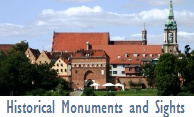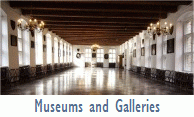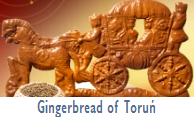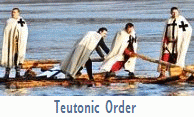|
The Star House
Kamienica Pod Gwiazdą
Address:
Opening hours: High season (May - September): Tue - Sun: 11am - 6pm | Mon: closed Low season (October - April): Tue - Sun: 10am - 4pm | Mon: closed Admission fees (without reservation charge): 8 PLN, reduced: 5 PLN Booking guides, entrance tickets, further details: Toruński Serwis Turystyczny (Toruń Tourist Service), tel. (+48) 66 00 61 352, e-mail: muzeum@turystyka.torun.pl  The Star House is one of the most sumptuous and best preserved Baroque patrician houses in Central and Northern Europe. Before the thorough reconstruction into Baroque style, in 1496 it had been owned by Filippo Buonaccorsi (known also as Callimachus) - famous Italian humanist, poet, diplomat and tutor to Polish King Casimir Jagiellonian's sons. The facade (richly decorated with fruit-and-flower stucco ornamentation), the layout and the interiors (richly carved timber stairs, painted timber ceilings etc.) have preserved the characteristic features of Northern European patrician residence typical of 18th century.
Permanent exhibitions:
 Renaissance and Baroque interiors of Toruń's patrician house Renaissance and Baroque interiors of Toruń's patrician house In the second half of the 16th century this Gothic house (built at the end ot he 13th century) got its present layout. It is then that sectional ceilings on the second floor, a ceiling polychrome on beams of the High Vestibule and on the deal-floor of the ground back bay and the gallery in the mid bay between the floors were added to the decor. The High Vestibule was rebuilt at that time either; its south-west part was equipped with so called suspended room meant for a merchant's counting office. There is the trace of it on the ceiling, as a different polychrome of the beams. It is worth mentioning that the ceiling polychrome in the Star House is one of the most interesting and valuable as well as the biggest among relatively numerous polychromes in historic tenement houses in Toruń.
At the end of the 17th century the owner of the building, Johan Georg Zöbner (a rich merchant, jury man, councilor) decided to give it modern (Baroque) and representative look by decorating the facade with opulent stuccos and putting the star on the gable. The old stairs were replaced with the new ones, whose first step is decorated with the statue of Minerva on the left and the figure of a lion with a shield and the date 1697 on it on the right. The alterations were introduced in the period of classicism – the room in the first floor was decorated with ilusionistic polychrome (presently reconstructed).
In the second half of the 19th century the chimney was replaced with the second winding staircase, cast-iron one. i  The World of Orient The World of Orient Monuments of Chinese, Japanese, Indian, Korean, Vietnamese art and art handicraft. The oldest ones are the Chinese and come from the times of Han dynasty (206 BC - 220) with which the first china artefacts are connected.
The Far East weaponry and armaments. Bronze objects. Sculptures in stone and wood. The ceramics. Objects made of half-precious stones.
The Toruń's collection of Far East art is unique set of orientalia items in Poland.
|
| All rights reserved Toruń 2005-2009 | About us | CenterMedia |




















